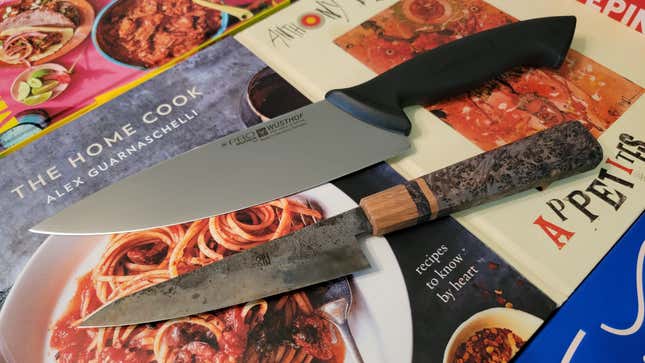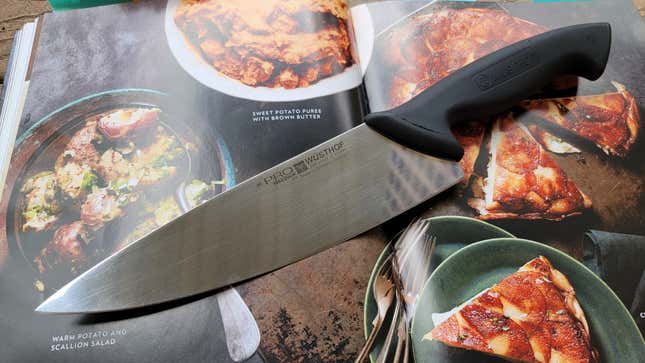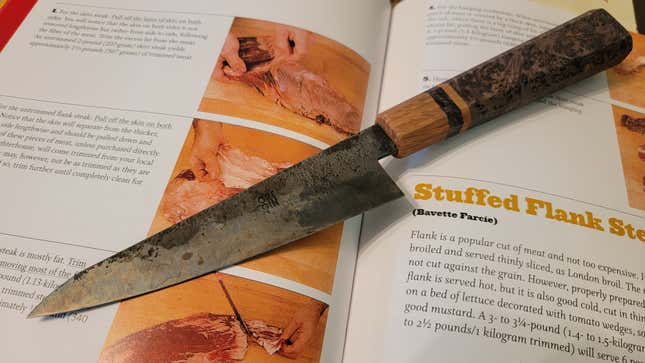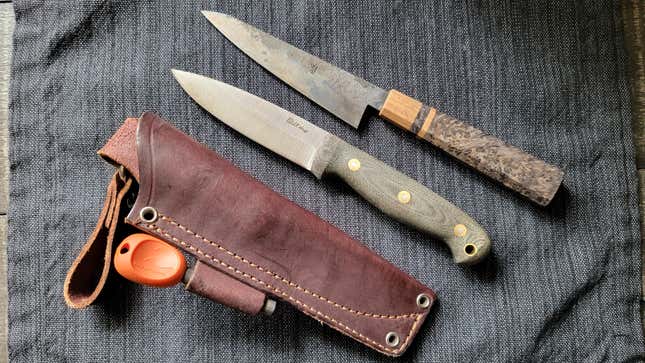
In the kitchen, I’m like the Harpo Marx of knife work; meaning that I never had any formal training, and just messed around until I found something that worked for me. But along the way, I’ve learned a lot about blade geometry, steels, and the general ins and outs of chef’s knives. So, when the opportunity came along to compile some of this knowledge for The Takeout, my eyes glazed over and I got a goofy grin on my face.
Like I said, pure Harpo. And speaking of clowns: Yes, I’m the same guy that wrote a piece telling you to put your blades in the dishwasher. But even I’m not lazy enough to do that with my nice chef’s knife. These are the tools of a craftsperson, and there’s a right way to care for them.
What’s more subjective, however, is preference. And if you’re looking to step up from that dollar-store blade you’ve been using since college, the variety of choices and styles can be overwhelming. But over a few years of cooking and writing about knives, I’ve learned what to look out for and even have some recommendations to share, from great all-around models to a few unique outliers.

Consider the blade style and length
Retailers offer a wealth of blade styles, but we’re really focused on two: the traditional Western chef knife and its sleeker Japanese counterpart. The Wüsthof Pro Chef’s Knife pictured above is a pretty typical example of the Western style. There’s a pronounced curve to the belly, allowing you to rock back and forth through piles of foodstuffs. The Japanese type are generally more angular, with slightly different tip geometry. They’re great slicers, but offer a bit less all-around versatility. If you use the flat of your knife blade to smash garlic, for instance, just know that your palm will have a smaller target.
If you’re buying a Western-style blade, you can generally rest assured that it’ll come with a V-ground bevel. This is just what it sounds like: The two sides of the blade’s edge join in the shape of the letter V. Japanese knives can be trickier. Some ship with a chisel bevel, meaning that only one side of the final edge comes in at an angle.
Whole books have been written on this subject, and I won’t attempt to get into it here. What it boils down to is this: A Western knife will generally be easier for a home cook to sharpen and hone. And if you’re buying an Eastern-type blade from a Western maker, you’ll probably get the V. But if you, like many pro chefs, want the full-on Japanese experience, pay attention to the product description. You don’t want to buy a right-handed bevel if you’ve got a left-handed grip. Again, this isn’t a hard and fast rule, as some Japanese makers do produce V (or even hybrid) edges. Just be sure to do your research.
Regardless of your preferred style, most folks should look for a blade with around eight inches of reach. This is a good do-anything range, allowing you to cut through large hunks of produce while still being nimble enough to execute a fine mince.

The materials that make up your knife matter
After picking a style, you’ll want to consider its steel. This is an even more complicated topic, so here are the highlights: Most Western knives are made with a slightly softer metal, while Japanese blades go harder. Hardness is measured on something called the Rockwell Scale, with a unit called HRC. Quality offerings in the western-style will generally weigh in between 55-58 HRC, while many Japanese knives are hardened to 60 HRC and above.
A steel’s name can also help you out. VG-10 and Molybdenum alloys are popular with the Eastern models, while the West prefers various members of the High Carbon families. Just keep in mind these later options will corrode or discolor pretty quickly if not dried promptly after use. Spyderco’s LC200N is on the opposite end of the spectrum, with a metallurgy that is, for all intents and purposes, rust-proof.
For beginners and home cooks, I’d generally steer you toward something on the softer end. They’re more forgiving to learn with, both in cutting and sharpening. Say you accidentally smack your edge against the faucet—a more malleable steel will deform with the impact, where a harder metal is likely to chip, and a roll in the edge is much, much easier to correct than a chip.
Steel usually receives top billing, but don’t overlook the handle material. Various rubbers, polymers, and stabilized wood will usually fit the bill, like Pakkawood or Mercer’s Santoprene. But in general, raw wood or hard plastic will grow slippery or uncomfortable over extended use.
The best starter chef’s knives
Wüsthof Classic 8-Inch Chef’s Knife ($170)
This is one of the more iconic designs in the industry. With its tall, high-carbon blade and thoughtfully-sculpted grip, this chef’s knife is a paragon of comfort and performance. If there’s a downside here, it’s that the heel of the blade meets a thicker piece of steel. This will make it harder for home sharpeners to touch up that aft bit of edge. Still, the Wüsthof name carries weight, and their Classic 8 is a legitimate beast.
Mercer Culinary Genesis 8-Inch Chef’s Knife ($37)
The budget waters are hotly contested these days, but this Mercer is near the top of the pack. The curve of its high carbon blade is elegant, and the hooked end of its Santoprene handle should keep your hand locked in place. And with more than 10,000 five-star reviews on Amazon, it certainly has an enthusiastic customer base. Is it enough to topple the previous budget king, the Victorinox Fibrox Pro? Depending on your hand size and preferred grip, I’d wager the answer is “Yes.”
Mac Mighty 8-Inch Chef’s Knife ($150)
However you look at it, the Mac Series is legendary. Their Mighty has topped lists of the “Best Chef’s Knives” from all across the industry. Their design and construction are superb, and they’ve got that slice-y feel of the best Japanese blades. There are also some less-expensive (but no less capable) offerings in their line, like this Hollow Edge model for $90.

Handmade knives are always an option
Depending on how much you believe in the idea of tools having “soul,” there’s something to be said for handcrafted knives. And while there are plenty of high-end options out there, I’d also encourage you to check out smaller makers like LT Wright. This company is producing well done, personally crafted blades with beautiful materials. I’ve used one of their GNS models as an all-around camping companion for years, and it’s been great.
Taking the second-life concept a step further, there’s also a company named Origin Handcrafted. Their new Culinary Series produces knives in the Japanese style, forged from vintage sawmill blades, whisky barrels, and locally sourced oak up in Manitoba. They recently sent me a Utility knife to test, and it’s been nothing short of excellent. They’ve got about a week left on their Kickstarter, so I’d recommend giving them a look.